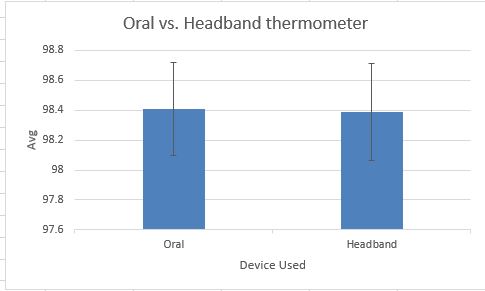BME100 f2013:W1200 Group5 L3
| Home People Lab Write-Up 1 | Lab Write-Up 2 | Lab Write-Up 3 Lab Write-Up 4 | Lab Write-Up 5 | Lab Write-Up 6 Course Logistics For Instructors Photos Wiki Editing Help | |||||||
|
OUR TEAM
LAB 3A WRITE-UPDescriptive Statistics(Descriptive statistics for the data set) Mean Body Temperature (measured in degrees Fahrenheit) Oral Thermometer: 97.56 Mode for Body Temperature (measured in degrees Fahrenheit) Oral Thermometer: 97.4 Median Body Temperature (measured in degrees Fahrenheit) Oral Thermometer: 97.6 Standard Deviation Oral Thermometer: 1.030571459 Standard Error Oral Thermometer:0.083045815
Results(Well-labeled graph with error bars and significance)
Analysis(Perform inferential statistics described in assignment.)
T-Test Statistical difference between measurements: 1.91908E-16 Because the T-Test shows a significant difference between the two measurements, we can conclude that the Iphone sensor does not yield the same temperatures as the oral thermometer. Further more, the two measurements do not show a correlation (as pictured below). Pearson's R r=0.021714709
Summary/Discussion(Please discuss the results and statistical analysis. State your conclusion as well as design flaws and recommendations.) Conclusion We attempted to compare the iPhone sensor to the gold standard of temperature measurement, the oral thermometer. However, these two devices gave different readings, allowing us to conclude that the iPhone sensor was not an accurate measure of body temperature. The t-value of the experiment, 1.91908*E-16, showed that there is a significant difference between the sets of data acquired from the iPhone sensor and oral thermometer. In addition, the Pearson's R value was 0.021714709, meaning that there is no correlation between the measurements of the oral thermometer and those of the iPhone sensor. If the iPhone sensor was accurate, there would have been a minimal statistical difference between the two measurements and our P value for the t-value from the t-test would have been high (which was not the case). To conclude, this means that this device is not a viable means of measuring body temperature, since its measurements are not as accurate to the measurements of the oral thermometer. Design Flaws and recommendations Having a wireless device created various problems with user comfort. The sensor was meant to be secured to the body with tape, however more tape was needed than was included with the product. In addition, in a high activity setting it is doubtful that the product would stay secured in the correct position for an accurate readout. Because the accuracy of the device is dependent on the device being secured correctly to the person wearing it, the potential for incorrect readings is high. A more effective way could be to create a band that would secure around the arm and hold the device in place, much like the iPod arm bands that could be used for jogging or other aerobic activities. Giving the sensor a longer battery life. During testing, the device would sometimes die due to a lack of battery life. A suggestion would be to give the device a longer battery life through a better battery. Batteries are made smaller and smaller every day and are able to last longer and longer. A longer lasting battery would be an easy fix for one of the issues that the device has. Another problematic function of the sensor was the Bluetooth connection to the iPhone. Every device connected in the lab utilized the same label on the Bluetooth network which made it difficult to differentiate each device's readout as well as originally connect to the device because it was nearly impossible to locate the correct individual device. Also, the connection between the device and the iPhone was not strong and the readout on the iPhone sometimes showed a loss of connection to the iPhone. Often times after that, it would become somewhat difficult to reconnect. In order to correct this problem the device would have to be hard wired to give the readouts itself, or a stronger wireless adapter, or something to make the connection between the two stronger would have to be used. Lastly, the temperature recordings of the iPhone sensor did not seem to be consistent with the true core temperature of the human body. At times, the sensor would measure the subject's temperature to be 96 or 95 degrees, which is not close to the true body temperature of the subject. It is worth noting that the sensor itself was neither accurate or precise, with a huge standard deviation compared to the oral thermometer.
LAB 3B WRITE-UPTarget Population and NeedTarget Population: Athletes of all calibur or any of the general population that is active. Device DesignHot Head: The only way to tell how hot you really are. This device is equipped with a sensor on the inside of the band that measures body temperature in much the same way your doctor would with the forehead thermometer. The signal then transmits wirelessly to your blue-tooth capable device. In order to improve upon the connections of past body temperature measurement devices, the headband has been fitted with a stronger adapter to send and receive the signal. Upon receiving your device you will get instructions on how to register it online so that you can individually label your device for easier detection and keep a record of the devices readings.
Inferential Statistics
Sensor: GraphResults of Oral thermometer vs. Headband
| |||||||





